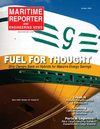
Page 26: of Maritime Reporter Magazine (October 2025)
Read this page in Pdf, Flash or Html5 edition of October 2025 Maritime Reporter Magazine
ICEBREAKERS | RUSSIA & CHINA nese delegates prioritized energy and shipping routes along- have slowed progress. China has the industrial capacity to step side technological innovation. Both sides agreed that technol- in, but Moscow’s longstanding caution in transferring its nuclear ogy — from AI-based monitoring to submarine cable systems propulsion know-how remains a point of friction. Cooperation — will drive future cooperation, but Russia focused on carbon has therefore focused on ice-class LNG carriers and conven- emission management, resource extraction, and economic de- tional ice-capable cargo ships, areas where Chinese shipyards velopment, whereas China stressed using technology to deep- have proven capabilities and may expand into auxiliary systems, en its international Arctic engagement. modular construction, and non-nuclear propulsion integration.
These differences matter for icebreaker collaboration — Outside the Russia–China axis, the West is also scaling up. In
Russia sees them as tools for sovereignty and economic con- November 2024, the United States, Canada, and Finland signed trol; China views them as enablers of trade access and tech- the Icebreaker Collaboration Effort (ICE) Pact, pooling resourc- nological prestige. es for Arctic and polar icebreaker development. At a March 2025 meeting in Helsinki, the partners outlined cooperation on design
The Northern Sea Route and Infrastructure Push innovation, workforce training, and research and development.
The NSR runs the length of Russia’s Arctic coast — 24,140 ki- lometers (almost 15,000 miles) — linking the Barents Sea to the Strategic Outlook
Bering Strait. In optimal conditions, it can cut travel time between The Arctic icebreaker market is at the center of a broader
Asia and Europe by up to 40% compared to southern routes. strategic competition. Russia seeks sovereign control and re-
Hence, for Russia the NSR offers market diversi? cation and source dominance; China looks for diversi? ed trade routes logistical opportunities, while also unlocking greater access to and a technological foothold; the West aims to counter both offshore Arctic resources and reinforcing its security, geopo- through alliances like the ICE Pact.
litical in? uence, and economic development. For China, whose For the maritime industry, this “push–pull” dynamic pres- southern trade routes pass through U.S.-in? uenced chokepoints ents both risks and opportunities. On one side is a Russia– like the Strait of Malacca and Suez Canal, the NSR offers both China bloc developing icebreakers outside Western supply strategic independence and economic ef? ciency. Access to Arc- chains. Russia’s need to modernize and expand its icebreaker tic hydrocarbons — estimated at 30% of undiscovered natural ? eet ensures long-term demand for hulls, coatings, propulsion gas and 13% of undiscovered oil — is an added incentive. units, navigation systems, and cold-weather operational gear.
But infrastructure alone cannot make the NSR viable year- China’s own ambitions under the “Polar Silk Road” will likely round. Ice conditions still restrict navigation for much of the drive parallel demand for commercial and research icebreak- year. Russia has invested in ports, logistics hubs, and ad- ers, supported by provincial-level shipbuilding initiatives.
vanced navigation systems, but without suf? cient icebreaker On the other, Western-led initiatives such as the ICE Pact escorts, traf? c volumes will remain seasonal. The NSR’s fu- will compete for technological leadership, setting new design ture as a commercial artery will ultimately depend on the pace and performance benchmarks. This bifurcation of the market of icebreaker construction. means suppliers in propulsion systems, ice-resistant materials, autonomous navigation, climate-adapted radar, and nuclear
Shipbuilding and Icebreaker Demand marine engineering could ? nd demand on bothe sides — if
Russia’s icebreaker ? eet — the largest in the world — in- they navigate export control regimes carefully.
cludes nuclear-powered Project 22220 vessels (Arktika, Sibir, In short, while the Russia–China Arctic relationship is not
Ural) designed to penetrate ice up to three meters thick at a seamless, its very frictions may expand the overall icebreak- speed of 22 knots in clear water, diesel-electric models, and er market by driving both states to invest heavily in paral- aging Soviet-era ships. The next generation, expected to come lel capabilities. For builders, component manufacturers, and online around 2030, will center on the massive icebreakers, service providers, the Arctic icebreaker sector over the next designed to break through ice up to 4.3 meters thick and clear a decade will be one of the few maritime domains where geo- channel up to 50 meters wide for extended navigation seasons. politics, climate change, and industrial strategy align to sus-
Industry plans call for as many as 15–17 nuclear icebreak- tain high-value demand.
ers to meet projected cargo volumes of 100–150 million
Sources: tonnes, driven largely by LNG, crude oil, and metals exports 1. Carnegie Endowment from the Arctic. This will require sustained investment in new 2. GIS Reports Online construction, maintenance, and repair capacity — areas where 3. World Nuclear News sanctions have already created bottlenecks.
4. Intelatus Global Partners proprietary data 5. U.S. DHS
Sanctions have slowed these ambitions — historically reliant 6. Geopolitical Monitor on Finnish yards for high-end builds, Russia is now pushing do- 7. ScienceDirect mestic production, but delays linked to restricted access to West- 8. Oxford Institute for Energy Studies ern propulsion systems, high-grade steel, and marine electronics 26 Maritime Reporter & Engineering News • October 2025
MR #10 (18-33).indd 26 MR #10 (18-33).indd 26 10/3/2025 2:38:37 PM10/3/2025 2:38:37 PM

 25
25

 27
27
